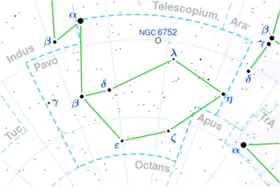Astronomy:Epsilon Pavonis
| Observation data Equinox J2000.0]] (ICRS) | |
|---|---|
| Constellation | Pavo |
| Right ascension | 20h 00m 35.55558s[1] |
| Declination | −72° 54′ 37.8198″[1] |
| Apparent magnitude (V) | 3.97[2] |
| Characteristics | |
| Spectral type | A0 Va[2] |
| U−B color index | −0.05[3] |
| B−V color index | −0.03[2] |
| Astrometry | |
| Radial velocity (Rv) | −6.7±0.7[4] km/s |
| Proper motion (μ) | RA: +81.78[1] mas/yr Dec.: −132.16[1] mas/yr |
| Parallax (π) | 31.04 ± 0.17[1] mas |
| Distance | 105.1 ± 0.6 ly (32.2 ± 0.2 pc) |
| Absolute magnitude (MV) | 1.43[2] |
| Details | |
| Mass | 2.2[5] M☉ |
| Radius | 1.74[6] R☉ |
| Luminosity | 32[7] L☉ |
| Surface gravity (log g) | 4.32±0.02[6] cgs |
| Temperature | 10,440[8] K |
| Rotational velocity (v sin i) | 85[7] km/s |
| Age | 27[6] Myr |
| Other designations | |
| Database references | |
| SIMBAD | data |
Epsilon Pavonis, Latinized from ε Pavonis, is a single,[9] white-hued star in the constellation Pavo. It can be viewed with the naked eye, having an apparent visual magnitude of 3.97.[2] The annual parallax shift of 31.04[1] mas provides a distance estimate of 105 light years from the Sun. This star is a member of the proposed Argus Association, a young moving group of more than 60 stars associated with the IC 2391 cluster.[10] Epsilon Pavonis is moving closer to the Sun with a radial velocity of −6.7 km/s.[4]
With a stellar classification of A0 Va,[2] Epsilon Pavonis is an ordinary A-type main-sequence star that is generating energy through hydrogen fusion at its core. It is just 27[6] million years old with a projected rotational velocity of 85[7] km/s. The star has 2.2[5] times the mass of the Sun and 1.74[6] the Sun's radius. It is radiating 32[7] times the Sun's luminosity from its photosphere at an effective temperature of 10,440 K.[8]
References
- ↑ 1.0 1.1 1.2 1.3 1.4 1.5 Van Leeuwen, F. (2007). "Validation of the new Hipparcos reduction". Astronomy and Astrophysics 474 (2): 653–664. doi:10.1051/0004-6361:20078357. Bibcode: 2007A&A...474..653V. Vizier catalog entry
- ↑ 2.0 2.1 2.2 2.3 2.4 2.5 Anderson, E.; Francis, Ch. (2012). "XHIP: An extended hipparcos compilation". Astronomy Letters 38 (5): 331. doi:10.1134/S1063773712050015. Bibcode: 2012AstL...38..331A. Vizier catalog entry
- ↑ Mermilliod, J. C. (2006). "VizieR Online Data Catalog: Homogeneous Means in the UBV System (Mermilliod 1991)". VizieR On-line Data Catalog: II/168. Originally Published in: Institut d'Astronomie 2168. Bibcode: 2006yCat.2168....0M.Vizier catalog entry
- ↑ 4.0 4.1 Gontcharov, G. A. (2006). "Pulkovo Compilation of Radial Velocities for 35 495 Hipparcos stars in a common system". Astronomy Letters 32 (11): 759–771. doi:10.1134/S1063773706110065. Bibcode: 2006AstL...32..759G.
- ↑ 5.0 5.1 Tetzlaff, N.; Neuhäuser, R.; Hohle, M. M. (2011). "A catalogue of young runaway Hipparcos stars within 3 kpc from the Sun". Monthly Notices of the Royal Astronomical Society 410 (1): 190–200. doi:10.1111/j.1365-2966.2010.17434.x. Bibcode: 2011MNRAS.410..190T. Vizier catalog entry
- ↑ 6.0 6.1 6.2 6.3 6.4 Gerbaldi, M. et al. (June 1999), "Search for reference A0 dwarf stars: Masses and luminosities revisited with HIPPARCOS parallaxes", Astronomy and Astrophysics Supplement 137 (2): 273–292, doi:10.1051/aas:1999248, Bibcode: 1999A&AS..137..273G.
- ↑ 7.0 7.1 7.2 7.3 Zorec, J.; Royer, F. (2012). "Rotational velocities of A-type stars". Astronomy & Astrophysics 537: A120. doi:10.1051/0004-6361/201117691. Bibcode: 2012A&A...537A.120Z. Vizier catalog entry
- ↑ 8.0 8.1 David, Trevor J.; Hillenbrand, Lynne A. (2015). "The Ages of Early-Type Stars: Strömgren Photometric Methods Calibrated, Validated, Tested, and Applied to Hosts and Prospective Hosts of Directly Imaged Exoplanets". The Astrophysical Journal 804 (2): 146. doi:10.1088/0004-637X/804/2/146. Bibcode: 2015ApJ...804..146D. Vizier catalog entry
- ↑ Eggleton, P. P.; Tokovinin, A. A. (2008). "A catalogue of multiplicity among bright stellar systems". Monthly Notices of the Royal Astronomical Society 389 (2): 869. doi:10.1111/j.1365-2966.2008.13596.x. Bibcode: 2008MNRAS.389..869E.
- ↑ Zuckerman, B. et al. (May 2011). "The Tucana/Horologium, Columba, AB Doradus, and Argus Associations: New Members and Dusty Debris Disks". The Astrophysical Journal 732 (2): 19. doi:10.1088/0004-637X/732/2/61. 61. Bibcode: 2011ApJ...732...61Z.
 |


